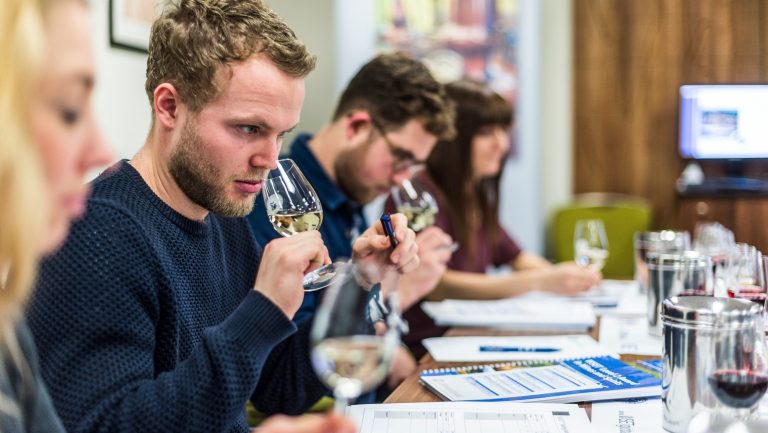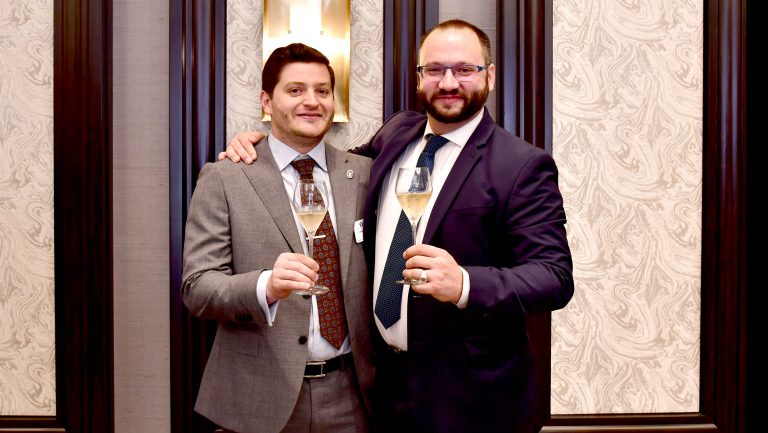This article was originally published in October 2017 and has been updated.
The demand for education in the beverage sector—especially wine—is high, with more program providers popping up across the country and classes selling out in major markets. In the 2021/2022 academic year, the Wine & Spirit Education Trust (WSET), the largest global provider of wine education, reported that 117,000 students enrolled for a WSET qualification worldwide—an eight percent increase over the previous year. The United States is WSET’s largest market, registering over 23,000 candidates—a 15 percent increase over the previous year.
Why the spike? As more consumers explore an expanding selection of wines, “more and more businesses are recognizing that education and well-trained staff are the foundations of better customer service and stronger profits,” says David Rudman, DipWSET, the executive director for WSET Americas. WSET offers four levels of wine certification (plus several awards in spirits and sake), which also serve as stepping stones to the Master of Wine (MW) credential.
It’s a similar story at the Court of Master Sommeliers, another leading wine education program—it also offers multiple tiers of certification, culminating in the Master Sommelier (MS) diploma. “After a challenging time due to COVID, we have restored a full schedule of in-person programming,” says Julie Cohen Theobald, the executive director of the Court of Master Sommeliers, Americas. “2022 was a great year for us, doubling participation versus 2021 and serving approximately 6,500 students.”

Don’t miss the latest drinks industry news and insights. Sign up for our award-winning newsletters and get insider intel, resources, and trends delivered to your inbox every week.
Advanced credentials help professionals bolster their careers in a number of ways—their salaries and titles may be amped up, and the credentials can even lead to business start-ups. Says Nicholas Paris, MW, “My career was already on a steady incline prior to receiving the MW, but almost overnight it felt as if I had been catapulted upwards. I received emails and phone calls asking me to judge at various prestigious wine competitions and be a speaker at multiple wine conferences.” Within his own company, E. & J. Gallo Winery, he became a director and negotiated a higher salary. Paris is now director of global sourcing at Gallo in New York City. And as far as intangible benefits, he says that after passing the MW exam he felt a strong sense of personal satisfaction: “[T]he need to prove myself to myself disappeared.”
The Master of Wine program is generally pursued by a wide range of wine professionals, including importers, distributors, writers, winemakers, and other members of the trade, whereas the Court of Master Sommeliers’ program is geared toward on-premise professionals, focusing on beverage department management and service. The programs are both academically rigorous, it’s just a matter of approach: the Court of Master Sommeliers’ take is more hands-on and practical, whereas the Master of Wine program is more theoretical, with a strong writing component.
According to David Glancy, MS, the founder of the San Francisco Wine School: “In general, I’d say passing the MS or MW opens many doors. It can create perception issues that can be positive or negative—MSs are snobby or MWs are all theoretical and can’t sell wine, but 90 percent of the time, both open doors tremendously.”
For those who don’t have the resources or desire to become a Master Sommelier or Master of Wine, there are plenty of options that allow industry professionals to hop between curricula, picking up the discrete credentials they want from each. We spoke with students and graduates from the most popular programs in the country and discovered that one size doesn’t fit all.
Here, SevenFifty Daily examines the options, from the iconic multitiered programs to those with diverse à la carte offerings.
Court of Master Sommeliers
The Court’s three levels of certification lead to the Master Sommelier, the rigorous program chronicled in Somm and Into the Bottle, which helped heighten interest in the profession. To date, there are 272 Master Sommeliers worldwide and 167 in the Americas.
The Court of Master Sommeliers program includes service and business components tailored to professionals in on-premise operations. Though the first two levels often have enough availability to attract a mix of consumers and trade professionals, the advanced sommelier course and exam is notoriously in-demand. In 2022, the Court offered the advanced theory exam at local testing centers to cut down on travel expenses, according to Cohen Theobald, and in 2023 they will be opening the advanced sommelier exam to anyone who is eligible and expanding attendance for the advanced course by 25 percent.
Evan Goldstein, the eighth American to pass the Master Sommelier exam, some 30 years ago, says that “being an MS changed the paradigm” and “expedited” his career opportunities. Today he is off the floor and working as a cofounder of Full Circle Wine Solutions, a wine education and public relations firm based in the Bay Area, and Master the World, a tasting kit wine club; he is also the Master Sommelier for the San Francisco Giants baseball team.
Goldstein says that “proven increased compensation, prestige, and being part of an awesome and respected fraternity and of a globally respected institution” are just some of the reasons to pursue the credential. But he notes that “the commitment to do it is equally vast—time, [money], sacrifice vis-à-vis your personal life.” Still, he says, “I would venture that the upsides do outweigh the downsides.”
“Having the certification has opened doors, instilled credibility, surely contributed to public speaking opportunities, and perhaps expedited aspects of my career that might have organically taken longer,” Goldstein said.
Andrew McNamara, MS, the president of ACE Wine and Spirits in Tampa, Florida and a former chairman of the Court of Master Sommeliers, Americas, got his MS in 2007. He said the Master Sommelier program was a quantum leap in knowledge and critical thinking from the levels leading up to it. But, in the end, it’s about how people parlay their knowledge.
“You can pass any of the exams, but it’s what you do with it that matters,” he says. “For me, the credential opened doors and allowed [me] to get opportunities that might not otherwise [have been] there.”

What You Need to Know About Top Wine Education Programs
From Master Sommelier to Master of Wine and everything in between, there are plenty of ways to learn about wine. Compare costs, pros, and cons for each
Master of Wine
Administered through the Institute of Masters of Wine, the Master of Wine program is considered the industry’s most academic credential. The rigor and scope of this self-directed program makes it exceedingly difficult to attain; the MW is currently held by 414 people globally (498 have passed in total). And it’s not cheap: Some candidates estimate that they’ve spent upwards of $60,000 in exam fees, wine samples, texts, and travel over a multiyear period. Still, if you can handle the stress and market yourself with your newly minted degree, opportunity will knock, MWs say.
Christy Canterbury, MW, finished her WSET Diploma studies in 2003 and embarked on the MW the next year simply to increase her knowledge. “Then I realized it could take me places,” she says. It took her seven years and an estimated $60,000. “As hard as you think it will be,” she says, “multiply that by three. It will cost more than you think it will. It sucks up all your time and energy. You might even stop liking wine at some point. But if you make it through, it will have been worth it.” Canterbury went on to create her own business, through which she advises buyers and leads seminars, while maintaining a full schedule of international-competition judging and consulting.
Mary Gorman-McAdams, MW, had a similar experience; she started her MW program shortly after Canterbury finished hers and spent six and half years and about the same amount of money. “If you start because you have this romantic idea, you have to take a step back and prioritize,” she says. “One day you wake up and see the enormity of what’s in front of you and it’s frightening.” Her husband advised her not to look at the mountain but to just chip away at it. Gorman-McAdams says the program has checkpoints along the way—first-year assessments and structured support resources give candidates a lifeline. Candidates are also assigned a mentor.
Gorman-McAdams, who is an independent consultant, educator, and Bordeaux specialist and was formerly the director of the International Wine Center in New York City, says that having gone through the rigor and discipline of the program has enabled her to present herself with the confidence that comes from having a sound base of knowledge. Noting that the MW isn’t for everybody, she adds that lacking the advanced degree doesn’t mean a person hasn’t achieved a high level in the field. “The [WSET] Diploma is the most that most industry people need,” she says. “The MW is more about personal satisfaction.”
Wine & Spirit Education Trust
The WSET program is based in London and administered through 50 approved program providers in the U.S. Four levels of certification culminate in the Diploma, which is typically required for the MW program (an equivalent level of sommelier certificate or bachelor’s or master’s degree in wine may substitute). Students range from hobbyists to communications and wine-industry professionals, all of whom learn wine and spirits tasting through a progressive proprietary system. Unlike the Court of Master Sommeliers, the WSET program does not include a service component.
Deborah Parker Wong, who’s based in San Francisco, turned her Diploma credential into a teaching career, becoming a WSET-certified educator in the wine studies department at Santa Rosa Junior College in California. She also writes for several trade magazines, consults for private clients, and is a professional competition judge—all jobs she credits landing because of the credential. “It moved me to a new plateau where I could begin working at a higher level,” she says, “and that became another rung in the ladder toward becoming an expert in the subject matter.” But she cautions that while the Diploma telegraphs a level of fundamental knowledge that’s globally recognized, “it’s not what [it] can do for you; it’s what you can do with it.”
Parker Wong reflects on the pros and cons of the Diploma, saying, “No one teaches you how to evaluate the quality of wine like WSET. It enables me to sit on a panel with people who are extremely opinionated and have an equitable dialogue about the quality of the wine we’re looking at.” But, she says, in hindsight, she would have opted for a master’s degree in wine studies, which would have allowed her to teach at a university level, and gotten a trade certification later. “My most sage advice,” she says, “is weigh it very heavily against an academic degree.”
Society of Wine Educators
The Society of Wine Educators (SWE) offers a wide variety of certificate programs focused on wine and spirits, hospitality, and teaching. For Denise Clarke, who represents wine clients in her eponymous public relations firm in Austin, Texas, a combination of courses from the Court of Master Sommeliers, WSET, and the SWE helped her expand her knowledge base—and her presence in the wine community. “You can get invited to master classes [through these programs] and get to know people working the floor or focused on education—it’s fantastic networking,” she says. “I think the wine media I work with respect and appreciate that I know what I’m talking about. They know I’m not doing just a standard pitch.” Clarke completed the SWE’s Certified Wine Educator certificate in 2018 and the Wine Scholar Guild’s French Wine Scholar program in 2019.
Joe Roberts, the founder of 1 Wine Dude, parlayed his combined WSET and SWE credentials into a widely read blog, judging and industry speaking gigs, magazine columns, and an active travel schedule. While hobnobbing regularly with professionals holding master’s titles, he says, “I can count on one hand the number of people who have not accepted me as a peer.” He noted that without the certification it “would probably be more of an uphill climb.” His decision not to pursue a diploma-level program was based on his wish to get additional diverse work experience and spend more time with his young daughter.

The Changing Landscape of Wine Education
Shifts in traditional educational bodies and a wave of new resources have improved access to wine education—but is it enough?
When One Size Doesn’t Fit All
Not everyone wants or needs an uber-credential, and for such students a variety of programs exist, including those at the Wine Scholar Guild (WSG), which offers specialist certificates and concentrated regional study. Others would rather study wine as part of a broader hospitality management program, such as the one offered at the New York City College of Technology. Or, students can get one-stop-shopping at places like the San Francisco Wine School, which is an approved program provider for WSET, the Wine Scholar Guild, and SWE, as well as proprietary programs created by Glancy, the MS who founded the school.
“Our core vision was to bring all relevant credentials under one roof,” Glancy says, noting the major programs compete for students, when the reality is that not all students want all the offerings. By offering flexible education through a variety of means—online, short intensives, or longer-term on-sites—Glancy says students can get exactly the knowledge they want at various price points. The knowledge gained doesn’t go as deep as that of the most advanced programs, but students opting for shorter programs can get solid overviews and go on to develop expertise in their areas of interest through additional offerings.
Such is the case at the Wine Scholar Guild, where the president, Julien Camus, says his program’s students, 50 percent of whom are from the wine trade, are “looking to strengthen their working knowledge and understanding.” Started in 2005 under the moniker French Wine Scholar, the Wine Scholar Guild now includes French, Italian, and Spanish wine certificates and numerous specialist certificates. Camus says more than 10,000 students in total have completed WSG programs, including more than 5,000 students who have graduated from master-level programs focused on Burgundy, Bordeaux, Champagne, and the Loire Valley. National distributors have used the programs from Camus’s and Glancy’s schools in French and California wines, respectively, for staff training.
Jenni Burgess, a tech-industry professional in Sunnyvale, California, who also moonlights as a sommelier, completed six certificates at Glancy’s school as of 2017, including the Italian and French Wine Scholar programs. She says the Italian program in particular was “invaluable to me as a sommelier and a lover of wine. I can [now] root Italian wines in story and place for guests, provide context to enhance their experiences, and create an environment to help them explore.”
And for Dave DeSimone, a wine columnist for the Pittsburgh Tribune-Review, what began out of curiosity now has some serious legs to it. He completed the French Wine Scholar program without articulated career goals, but he now sees that the certification “conveys a certain amount of credibility along with a post-nominal title,” which, he suggests, might be useful for other projects, such as writing a book. He also holds the Bourgogne Master-Level certification from the Wine Scholar Guild.
Susannah Gold, the managing director of Vigneto Communications, a boutique public relations agency for the wine sector, counts certifications from WSET, SWE, the Italian Sommelier Association, the Wine Scholar Guild, and more among her credentials.
“I really believe in wine education and there are huge differences in the programs I did,” she says, noting they were variously focused on theory, business, chemistry, tasting, and service. “There’s that whole argument about whether you need education or practice on the floor: I would argue [we] need both.”
She added, “You have to think about what you want from it beyond just liking wine.”
Get more information on the structures, fees, pros and cons, and nominals for each of these programs in our wine education breakdown.

Dispatch
Sign up for our award-winning newsletter
Don’t miss the latest drinks industry news and insights—delivered to your inbox every week.
Lana Bortolot has written on food and wine for Forbes, Dow Jones, Wine Enthusiast, Saveur, and other magazines of the wine and spirits trade. She reported on real estate for the New York Times, Wall Street Journal, and New York Post, and on design for Entrepreneur magazine. She is a candidate for Wine & Spirit Education Trust’s Level 4 Diploma. Having covered most European wine regions and a few in South America, she is always looking to add a new wine-stained stamp to her passport.






